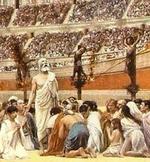They have no wine
By Phil Lawler ( bio - articles - email ) | Sep 23, 2011
“The Phoenix Diocese will stop offering consecrated wine for Communion at most Masses, a change considered one of the most fundamental to Roman Catholic Church customs in decades.”
Thus begins a strange news report in the Arizona Republic, on the decision by Bishop Olmsted to restrict the distribution of Communion under both species.
Since the new norms in Phoenix do no change the essential nature of Communion, it is more than a bit overwrought to describe the change as “one of the most fundamental to Roman Catholic Church customs in decades.” (And by the way, is the liturgy a “custom?”) But that is not my concern here. Rather, I want to call attention to the way the Republic story handles the very nature of the Eucharist.
The reporter stumbles several times as he tells this story. For instance:
A diocesan statement said the change was being made based on Bishop Thomas J. Olmsted's understanding of the church's new translation of the Mass, called the General Instruction of the Roman Missal…
No, the translation is found in the Roman Missal. The General Instruction is just a part of the Missal: an introduction of sorts.
The change will be one of the most significant in the Roman Catholic liturgy since the 1970s, when the distribution of wine was approved for the United States.
Not really. The distribution of wine was never approved. The distribution of the Blood of Christ was approved.
Communion, a sacrament that symbolizes a spiritual union with Christ…
Ooops! Wrong again. It’s not a symbol.
…is a widespread practice among Christian churches, following the commands of Jesus in the Gospels. But the Catholic Church believes the bread and wine used during the service actually are transformed into the body and blood of Christ.
Finally, there it is: the essential truth that puts the rest of the story in context! But it comes a bit late; by now the reader has absorbed several paragraphs of misleading information.
It might be too much to expect that a secular newspaper would identify the content of the chalice as the Blood of Christ. A reference to “consecrated wine” may be a safer option for editors who do not wish to offend either Catholic or non-Catholic readers. Still, if the reporter and editor wants his readers to understand what’s happening, they must provide accurate information on what Catholics believe.
In a non-Catholic newspaper, if you acknowledge that the chalice contains the Blood of Christ, you may be criticized for stating Catholic beliefs as established facts. But if you say that it is not the Blood of Christ—if you say flatly that it is wine—then you give an inaccurate impression of the Catholic liturgy. It’s a tough problem for a religion columnist--and one more reason why one cannot rely on the secular media for an accurate understanding of Catholicism.
All comments are moderated. To lighten our editing burden, only current donors are allowed to Sound Off. If you are a current donor, log in to see the comment form; otherwise please support our work, and Sound Off!
-
Posted by: Don Vicente -
Oct. 11, 2011 12:59 PM ET USA
Yes, it's terrible how non-Catholic newspapers get that mixed up. How about the headline in the National CATHOLIC Reporter yesterday: "Phoenix Diocese to Restrict Communion Wine"? I guess there must be a shortage of supplies from the wineries...
-
Posted by: AgnesDay -
Sep. 28, 2011 1:42 PM ET USA
One might wonder if there are any Catholics in journalism. Please don't count O'Reilly and Hannity.
-
Posted by: FrPhillips1125 -
Sep. 25, 2011 7:56 AM ET USA
I just saw a headline which proclaims, "Wine Dropped From Mass in Phoenix". Aside from the mental image it conjures, one might wonder if there are no editors left.
-
Posted by: -
Sep. 23, 2011 9:33 PM ET USA
Another thing about this article is their statement that no other diocese is following suite. While this may be true for the time being, another diocese that I know of already has this policy. The diocese of Lincoln, NE has had the policy for quite some time. And it is, by the way, the proper way to distribute communion under normal circumstances.








